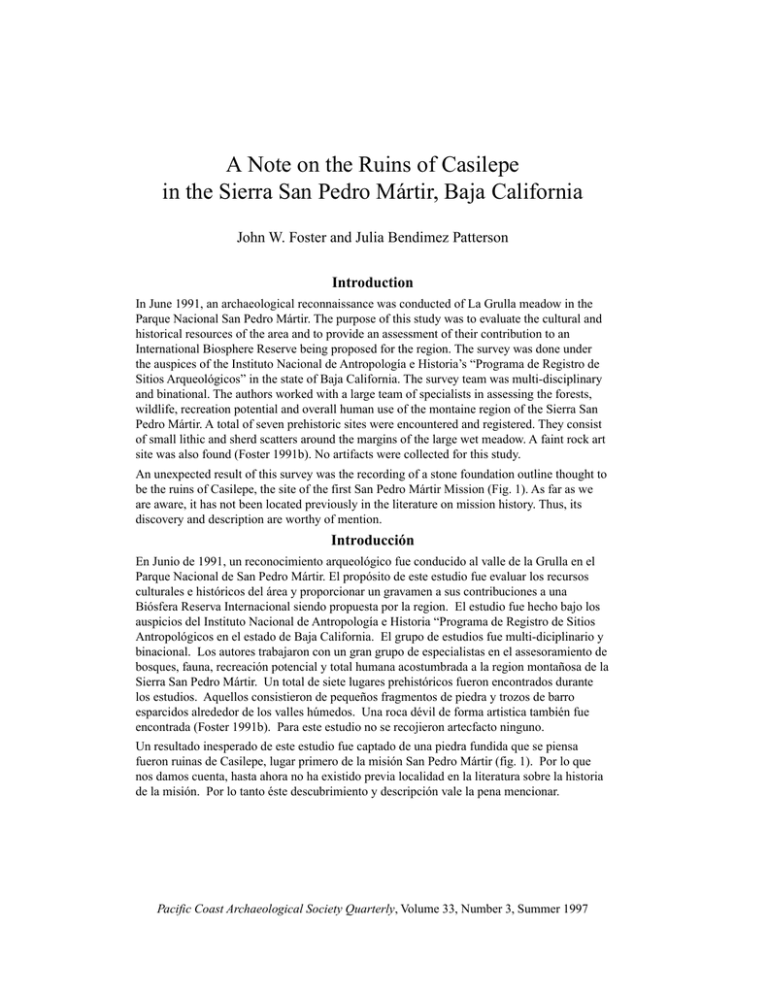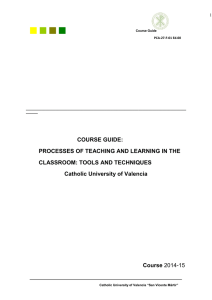A Note on the Ruins of Casilepe in the Sierra San Pedro Mártir, Baja
Anuncio

A Note on the Ruins of Casilepe in the Sierra San Pedro Mártir, Baja California John W. Foster and Julia Bendimez Patterson Introduction In June 1991, an archaeological reconnaissance was conducted of La Grulla meadow in the Parque Nacional San Pedro Mártir. The purpose of this study was to evaluate the cultural and historical resources of the area and to provide an assessment of their contribution to an International Biosphere Reserve being proposed for the region. The survey was done under the auspices of the Instituto Nacional de Antropología e Historia’s “Programa de Registro de Sitios Arqueológicos” in the state of Baja California. The survey team was multi-disciplinary and binational. The authors worked with a large team of specialists in assessing the forests, wildlife, recreation potential and overall human use of the montaine region of the Sierra San Pedro Mártir. A total of seven prehistoric sites were encountered and registered. They consist of small lithic and sherd scatters around the margins of the large wet meadow. A faint rock art site was also found (Foster 1991b). No artifacts were collected for this study. An unexpected result of this survey was the recording of a stone foundation outline thought to be the ruins of Casilepe, the site of the first San Pedro Mártir Mission (Fig. 1). As far as we are aware, it has not been located previously in the literature on mission history. Thus, its discovery and description are worthy of mention. Introducción En Junio de 1991, un reconocimiento arqueológico fue conducido al valle de la Grulla en el Parque Nacional de San Pedro Mártir. El propósito de este estudio fue evaluar los recursos culturales e históricos del área y proporcionar un gravamen a sus contribuciones a una Biósfera Reserva Internacional siendo propuesta por la region. El estudio fue hecho bajo los auspicios del Instituto Nacional de Antropología e Historia “Programa de Registro de Sitios Antropológicos en el estado de Baja California. El grupo de estudios fue multi-diciplinario y binacional. Los autores trabajaron con un gran grupo de especialistas en el assesoramiento de bosques, fauna, recreación potencial y total humana acostumbrada a la region montañosa de la Sierra San Pedro Mártir. Un total de siete lugares prehistóricos fueron encontrados durante los estudios. Aquellos consistieron de pequeños fragmentos de piedra y trozos de barro esparcidos alrededor de los valles húmedos. Una roca dévil de forma artistica también fue encontrada (Foster 1991b). Para este estudio no se recojieron artecfacto ninguno. Un resultado inesperado de este estudio fue captado de una piedra fundida que se piensa fueron ruinas de Casilepe, lugar primero de la misión San Pedro Mártir (fig. 1). Por lo que nos damos cuenta, hasta ahora no ha existido previa localidad en la literatura sobre la historia de la misión. Por lo tanto éste descubrimiento y descripción vale la pena mencionar. Pacific Coast Archaeological Society Quarterly, Volume 33, Number 3, Summer 1997 Foster and Patterson 30 Environmental Setting La Grulla is one of several high meadows within the Sierra San Pedro Mártir range. It is situated at an elevation of 2100 meters (almost 7000 feet) and covers an area some 6 km by 2 km in size in a NW to SE direction. Numerous spring-fed streams flow into the large meadow. These support a lush grassland that has attracted cattle grazing since mission times. Clay soils occur in the meadows, while granitic sand loams are more typical of the upland regions. Fig. 1. Location of hyposthesized Casilepe ruins within the Dominican frontier of Baja California. PCAS Quarterly, 33(3), Summer 1997 A Note on the Ruins of Casilepe 31 Surrounding the meadows is an extremely rugged pine forest with Jeffrey pine, lodgepole, cedar, white fir and aspen being most prominent. Understory vegetation is sparse. Succulents and cacti are occasionally seen, demonstrating the arid climate of the surrounding terrain. Large granite boulders are strewn across the landscape. They protrude through the soils and cap the hills and peaks surrounding La Grulla. These boulders form protected enclosures and occasional shelters around the margins of the meadow. The renowned naturalist José Longinos Martinez, during his botanical expedition to the Californias in 1791, journeyed to the Sierra San Pedro Mártir. He provided a description of the La Grulla meadow that is amazingly accurate today: Continuing in the same direction, over plateaus and ravines, at about eleven I came to a beautiful valley, some two leagues long and half a league wide, also free of trees and covered with cynodon. (This would be Bermuda grass, an alien species. He may have been describing Mulenburgia, a bunch grass instead.) The pines surrounding it are astonishingly large; I measured several of them which were fourteen to sixteen varas in circumference. The forest extends to the foot of several ranges of steep, high, and rocky peaks. In the thick grassy meadows of this valley, which could afford pasturage for every kind of cattle, I noticed small patches of the flax that is cultivated in Spain. There is a great deal of sage on the hills and in the surrounding valleys, together with madrono, tobacco, rose of Castile, larkspur, etc. The valley is well watered by five large streams flowing in from different directions, and at its entrance, through which all these streams discharge, it is somewhat marshy and has a deep pond, the source of the river flowing through Mission Santo Domingo. In spite of its sandy bed, most of the year it reaches the sea (Longinos Martinez 1961:40). At one time these high meadows apparently contained shallow lakes. This is evidenced by water marks on the granite boulders protruding from meadow soils. Explorers’ accounts of 1791 talk of a “great water” high in the mountains that was considered so sacred to the Kiliwa that it could not be drunk or even touched without fatal results (Longinos Martinez 1961:41). Sedimentation and arroyo cutting now prevent the impoundment of any substantial water at La Grulla, but its traces remain visible on the landscape. Mission San Pedro Mártir de Verona Early in 1792, authorization from Viceroy Revillagigedo was granted to proceed with a reconnaissance of possible mission sites in the northern frontier. Acting Governor José Joaquín de Arrillaga decided to establish three missions between the coastal settlements and the Colorado River. He sent reconnaissance expeditions into the Sierra, and they identified a suitable site for a new mission on a forested meadow on the high slopes of the Sierra San Pedro Mártir (Arrillaga 1969:14). PCAS Quarterly, 33(3), Summer 1997 32 Foster and Patterson On April 27, 1794, the Mission San Pedro Mártir de Verona was established in the high mountains at a place known to the natives as “Casilepe.” It was given the assignment to “proceed with the purpose of reducing the heathen who remained wild in the Sierra and on the shores of the Gulf.” The founding missionary is given as Padre Caetano Pallas, assisted or followed by Juan Pablo Grijalva and José Loriete (Robertson 1978:82, Mathes 1977:169). By July of that same year, it was reported to Governor Borica: The new foundation has not continued with the happiness with which it began. The crops have frozen and I have determined to move it to work at another place, situated on the western slope of the Sierra about three leagues distant from the other. A further report states: …the missionary at San Pedro Mártir says he will move the week that now ends, because of frosts and annoyances” (Meigs 1935:30). The final mission site is at a lower elevation and marked by adobe ruins, has been well reported by Meigs (1935) and Kurillo (1997). The earlier site, however has remained a mystery. Meigs has speculated that it must have been at one of the high meadows at La Grulla or La Encantada. He favored the latter as being closer to the main Indian trail allowing passage across the Sierra to the shores of the Gulf. Survey Methods An initial archaeological survey was carried out by an interdisciplinary team including C. Lucky Gillett (former resident of the Meling Ranch), and the authors. Access to the La Grulla meadow is by backpack. The team spent a total of three days in surveying the area surrounding La Grulla. The survey was intuitive in nature. It was discovered that the most productive areas seemed to be those adjacent to the meadow where shelter was afforded by large granite boulders. These were carefully examined around the perimeter of La Grulla meadow. All archaeological sites were mapped, recorded, photographed. A sample of artifacts was sketched for identification and later comparison. No collections were made at any site areas. Survey conditions were excellent. Grass cover was sparse and the ground surface was easily viewed. Orientation was not a problem since 1: 50,000 km maps were available for the La Grulla area. Survey Results A series of seven small aboriginal sites were recorded around the margins of La Grulla meadow. The remains of a rectangular stone foundation outline also was located. The archaeological deposits are found in small rock shelters or open camps with metate slicks and scatters of lithics. The largest, Site 1, did produce evidence of historic contact. It contains a rock shelter, milling surfaces, and a single cupule on the rim of a granite boulder. It covers an PCAS Quarterly, 33(3), Summer 1997 A Note on the Ruins of Casilepe 33 area 22 by 24 meters, some 40 meters in elevation above the meadow. The granite shelter (17 meters long) contains a dark midden and its roof is fire-blackened. This is the richest and most impressive archaeological deposit encountered at La Grulla. Artifacts are numerous. They include many scrapers and utilized flakes of chert, quartzite, rhyolite and jasper. Shell fragments also were seen (Foster 1991a). Of particular interest are pottery fragments strewn around the site. They are of two types. Most can be assigned to the typical Yuman tradition of plain wares. They are thin, well made, undecorated, sand tempered with occasional anvil marks and gold mica in the paste. Water containers and small bowls are represented forms. A total of five sherds, however, represent an important temporal clue. They can be attributed to non-Peninsula or mission contact, being thicker (12 mm +), poorly fired with a black biscuit and red slip over interior and exterior surfaces (cf. Ritter et al. 1995). They are tempered with coarse sand. Brush marks are present on several sherds. These probably reflect historic contact and mission influence, but they occur with typical Kiliwa sherds at the same site. Caselipe Ruins Centrally located on the edge of La Grulla meadow, and less than 100 m from the historic pottery at Site 1, is an alignment of foundation stones. As a working hypothesis, we propose this feature be considered evidence of the first San Pedro Mártir mission founded April 27, 1794. It consists of linear rock alignments forming adjacent rectangles (Fig. 2). The foundations are not complete. They are formed from a series of quarried granite stones set to form a one meter square. The squares are typically separated by 2.5 meters. Along several walls, the pattern is quite distinct. On others, it is very incomplete. The site measures 84 by 56 meters in size. It is anchored by two huge granite boulders aligned with the foundation corners. The plan appears to anticipate construction of two adjacent rectangles. One is almost square (58.5 by 56 meters) and the other is 20 by 26 meters. This would form a defensible perimeter with outbuildings for various industries and storage. (This is similar to the architectural pattern noted at other Dominican mission sites, including the second San Pedro Mártir mission.) Four circular pits are located immediately outside the southern foundation alignment. These may be borrow areas for construction materials, or housepits made by Indians assigned to work on the mission. No artifacts were seen on the surface. Typical Dominican mission construction consists of adobe walls set on a cobble foundation. When the site is eroded, the line of foundation cobbles and adobe melt can be clearly seen. This site is totally different. It may be that pine logs were planned as the principle construction material, and they were to be set on stone piers above the ground surface. In the limited time available to examine the site, it was not possible to expose the foundation blocks for further signs of architectural design. These studies await future research. The artifact yield from this massive site is extremely meager. Two mission period pottery sherds with a red slip were observed within the foundations. Otherwise, the site is devoid of PCAS Quarterly, 33(3), Summer 1997 Foster and Patterson 34 Fig. 2. Plan of possible ruins at Casilepe, site of the first Mission San Pedro Mártir. The site was established April 27, 1794 and moved to a more temperate locale by July of that same year. PCAS Quarterly, 33(3), Summer 1997 A Note on the Ruins of Casilepe 35 surface artifacts. This is significant for its interpretation since the only other possible function that such a massive construction would be as a cattle enclosure. The complete lack of any modern “cowboy” artifacts, however, as can be readily seen at numerous cattle enclosures and camps nearby, seems to argue against this explanation. Perhaps the strongest support for the mission hypothesis comes from Sr. Francisco Mayoral, director of staff at the Parque Nacional and a lifelong resident of the Sierra San Pedro Mártir. He states with absolute assurance that the ruins were not built by Sierra ranchers. They are, he claims, traditionally acknowledged as the remains of the first mission. It is possible the stone foundation ruins reflect initial efforts to establish a mission compound at almost 7,000 feet in the Sierra San Pedro Mártir. The enterprise was soon abandoned, and relocated to a sheltered valley at 5,500 feet. The new site was still the loftiest mission setting in Alta or Baja California. Here it managed to exist until about 1806 when the remaining native population was relocated to Mission Santo Domingo. Summary and Conclusions An initial survey of a remote high mountain meadow in the Sierra San Pedro Mártir has been completed. Conclusions must be tentative, awaiting further exploration and comparison. It can now be stated, however, that there is a considerable archaeological record of prehistoric inhabitants surrounding the meadows. This should be expected since early explorers like Arrillaga and Longinos Martinez told of numerous rancherias in the vicinity, and frequent Kiliwa hunting forays to the upland regions. We can now report that La Grulla meadow has begun to give up its historical and archaeological secrets. Prehistoric sites contain percussion flaked tools and late period points. Metates and mortars indicate extensive food preparation. Grass seeds, pine nuts and acorns were likely processed. Aboriginal Kiliwa pottery (indicating the presence of females as well as males) is present at the largest La Grulla site. Here, a deep midden deposit has accumulated. The general archaeological pattern is consistent with small family groups using the area seasonally over many generations. Other sites are small lithic scatters where pottery is absent. The extensive stone foundations laid out at La Grulla are possibly the remains of an aborted mission establishment at 7,000 foot elevation in the San Pedro Mártir range. Whether this was to be the mission itself, or a ranching outpost on the meadow has yet to be determined. Its incomplete state suggests abandonment as described for the Casilepe site. The mission era influence is also documented in the presence of non-Peninsular ceramics mixed with Kiliwa wares. Future studies are needed to provide a more complete interpretation. Acknowledgments This paper summarizes only one aspect of ongoing historical, ethnographic and archaeological research being conducted by the Instituto Nacional de Antropología e Historia (INAH) and the University Autónoma de Baja California (UABC). The authors have been working as part of a multi-disciplinary team to assess the natural and cultural values of the Sierra San Pedro PCAS Quarterly, 33(3), Summer 1997 Foster and Patterson 36 Mártir. Biosphere Reserve studies have been supported by the National Science Foundation through a U.S. Man and the Biosphere Program grant. Additional funds have been allocated by INAH and UABC. References Cited Arrillaga, José Joaquín 1969 Diary of His Surveys of the Frontier, 1796. Trans. by Frey Tiscareno and edited by John W. Robinson. Dawson’s Book Shop, Los Angeles. Foster, John W. 1991a An Initial Archaeological Reconnaissance of the La Grulla Meadow in the Sierra San Pedro Mártir. Paper presented at La XLVII Asamblea General de la Comisión de las Californias, Ensenada, Baja California. 1991b The Mission San Pedro Mártir de Verona: A Brief History and Assessment of its Potential Within a Biosphere Reserve. Paper presented at the International Conference on the Potential of the Sierra San Pedro Mártir as a Biosphere Reserve, Ensenada, Baja California. Kurillo, Max R. 1997 A Visual Survey of a Domnican Mission Site: Misión San Pedro Mártir de Verona. Pacific Coast Archaeological Society Quarterly, 33(3), Summer 1997. Longinos Martínez, José 1961 The Journal of José Longinos Martinez, Notes and Observations of the Naturalist of the Botanical Expedition in Old and New California and the South Coast, 1791-1792. Trans. and edited by Lesley Byrd Simpson. John Howell Books, San Francisco. Mathes, W. Michael 1977 Las Misiones de Baja California 1683-1849. Editorial Aristos S.A de C.V., La Paz, Baja California Sur. Meigs, Peveril, III 1935 The Dominican Mission Frontier of Lower California. University of California Publications in Geography, Vol. 7. University of California Press, Berkeley. Ritter, Eric W., John W. Foster, Robert I. Orlins, Louis A. Payen, and Paul D. Bouey 1995 Informative Archaeological Signatures at Bahía de Las Ánimas, Baja California. Estudios Fronterizos 35-36:151-186. Robertson, Tomás 1978 Baja California and its Missions. La Siesta Press, Glendale, California. PCAS Quarterly, 33(3), Summer 1997

